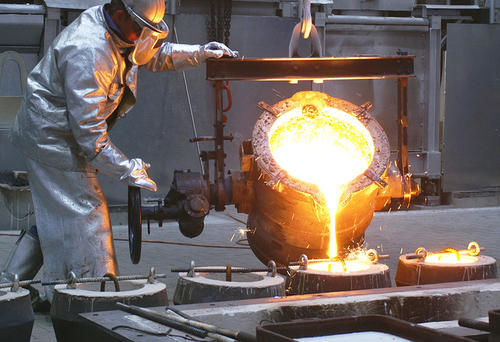Description of Gilsonite in Foundry
In Foundry and Refractories, for molding high-value metals there is more attention to factors such as finishing. Gilsonite can be a superior carbon additive replacing the traditional Sea Coal which has low Carbonic value compared to Gilsonite Specifications.
Gilsonite is used as a carbonate additive in casting sand to make plates smoother on gray iron molds. Adding Gilsonite makes a better mold that imparts a smoother finish to the cast piece and is easier to remove from the cast item.
Gilsonite is combined with coal and other ingredients as an additive in foundry sands to insure the quality of the molded part. The lower gas evolution should reduce ventilation load on the pouring floor. The physical property relationships developed in new sand mixes were confirmed by sand using Gilsonite as an additive. Casting finish of a Gilsonite mix has been equal to sea coal. Gilsonite is also used as a carbonated additive in casting sands that creates smoother plates on gray iron castings. In a lower temperature than coal, it makes the material volatile so that it improves the process of separating the metal from the mold.
Moreover, the surface of the mold is smoother and cleaner. gilsonite can be used as an additive to or a replacement to sea coal or other common carbonated additives in foundry. One of the great advantages of using gilsonite on sand mold is increasing the hot resistance, increasing the pure (dry) resistance, decreasing the penetration and increasing the hardness of the mold. Physical Sand properties with gilsonite resin are equal or superior to sea coal at significantly lower additive levels.
Gilsonite foundry additive for foundry sand pre-blends providing reduced smoke and other emissions, the additive comprising a mixture of one part iron oxide, one part of a highly volatile carbonaceous material such as Gilsonite , and four parts of metallurgical coke.
Foundry sands, which are composed mainly of silica sand with clays and carbonaceous materials mixed and pulled together when compacted to form molds, resist penetration by molten metal and the tendency of the molding sand to fuse or stick to the casting. One of the problems associated with the known blend carbonaceous additives discussed above, particularly believed due to sea coal, is the smoke and other emissions that can be environmentally hazardous. These gasses are released when the materials are heated in an oxygen-free atmosphere.
Foundry Sand
This sand is of a special type and mainly silica sand, which is obtained in limited areas in Iran and is used depending on the type and appearance of sand grains in the casting of small and large steel parts. Of course, there are other uses of this sand, especially in the treatment of drinking water and … But more than 80% of the mining of this mineral sand is used in the casting industry.
- Clay with water is used as a sandblast. General composition: 90% sand, 7% clay and 3% water Other adhesives that are used include:
- Organic dressings (such as phenolic resins)
- Inorganic labels (sodium silicate and phosphate)
Other alternatives, sometimes to increase strength and degradability
Sand adds to it.
Compounds of Gilsonite in foundry
Although the ratio of one part iron oxide, one part of a highly volatile carbonaceous material such as gilsonite and four parts of metallurgical coke in the additive is a preferred ratio to reduce smoke and/or emissions and give proper finish to the castings, some variations may be permissible. When the additive is combined with the clay, the nominal percentages by weight of the blend would be around 4% iron oxide, 4% gilsonite and 16% metallurgical coke, the balance being essentially 70% to 75% clays and small amounts of other materials. In the case of greater than normal amounts of smoke and/or emissions, the amount of the iron oxide can be increased in steps of 0.5% of the blend with a similar reduction in the metallurgical coke. In the case of poor shakeout peel or casting surface problems, the highly volatile carbonaceous material such as uintaite can be increased in 0.5% steps with a similar reduction in the clay portion of the blend. The permissible ranges of constituents beyond which the additive would be less effective, expressed as a percentage by weight of the blend, are 2%-6% iron oxide, 6%-2% uintaite, and 12%-18% metallurgical coke.
Advantages of Using Gilsonite as an additive in Foundry Sands
- High lustrous carbon for the better finish.
- Reductive atmosphere for less reaction between mold and casting for fewer imperfections
- Significant increase in gas generation comparing to Sea Coal.
Packing of foundry Gilsonite natural asphalt lump and powder form
Gilsonite in lump form like rock packed in the 500~1000 kg jumbo bag
Gilsonite 200 mesh packed in the 500~1000 kg jumbo bag
Gilsonite 300 mesh packed in the 500~1000 kg jumbo bag
Gilsonite 30-40 mesh packed in the 500~1000 kg jumbo bag
Gilsonite 100 mesh packed in the 500~1000 kg jumbo bag
Gilsonite 300 mesh packed in 25 kg pp bag
Gilsonite 200 mesh packed the 25 kg multi-paper bag
Gilsonite 200 mesh packed the 50 lbs multi-paper bag
Gilsonite 30-40 mesh packed pp bag on the pallet
ELEMENT ANALYSIS
| 1 | CARBON,WT% | 78 | ASTM-D5291 |
| 2 | HYDROGEN,WT% | 7.1 | ASTM-D5291 |
| 3 | NITROGEN,WT% | 3.67 | ASTM-D5291 |
| 4 | OXYGEN,WT% | 3.1 | ASTM-D5291 |
| 5 | SULPHURE,WT% | 2 | LECO(S)ANALYSER |


